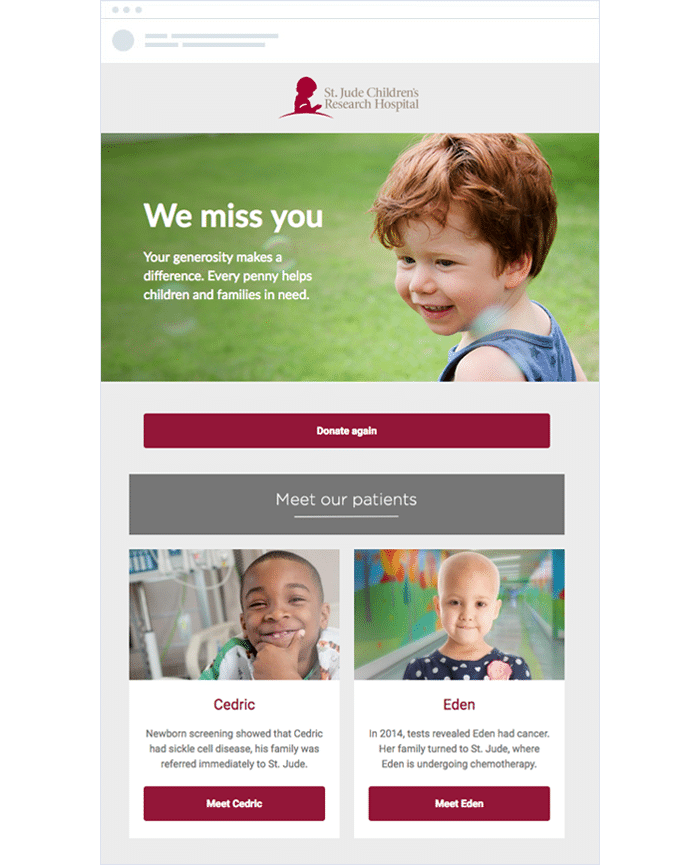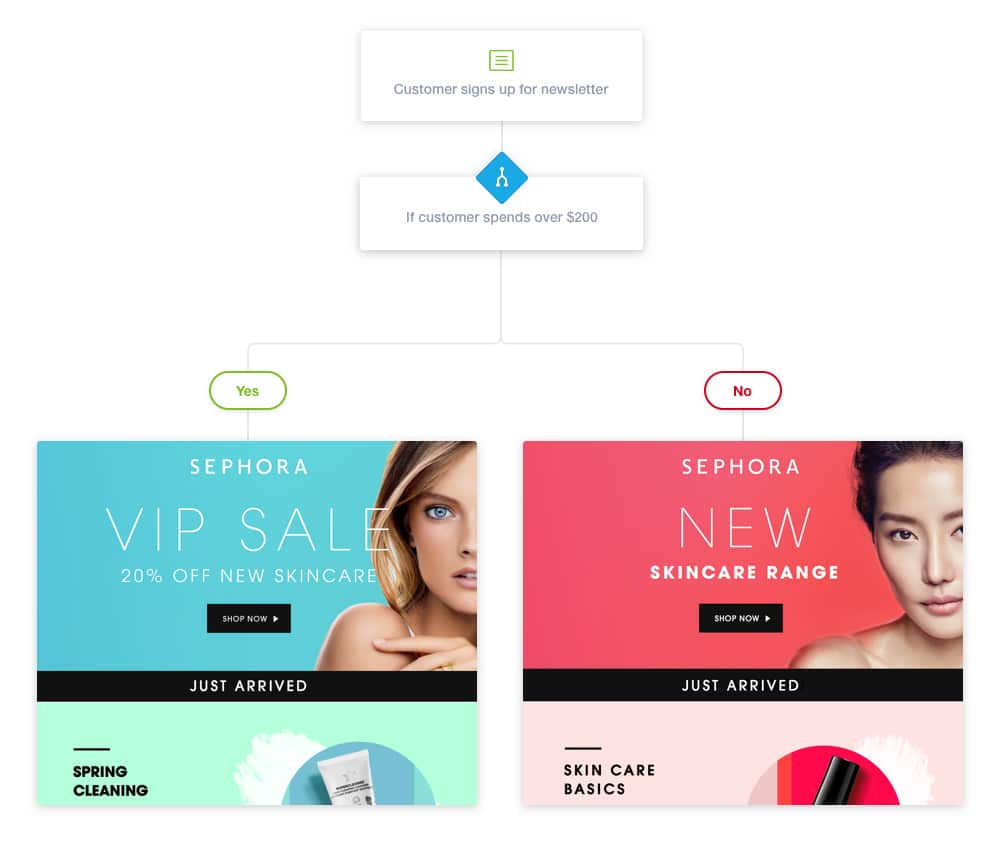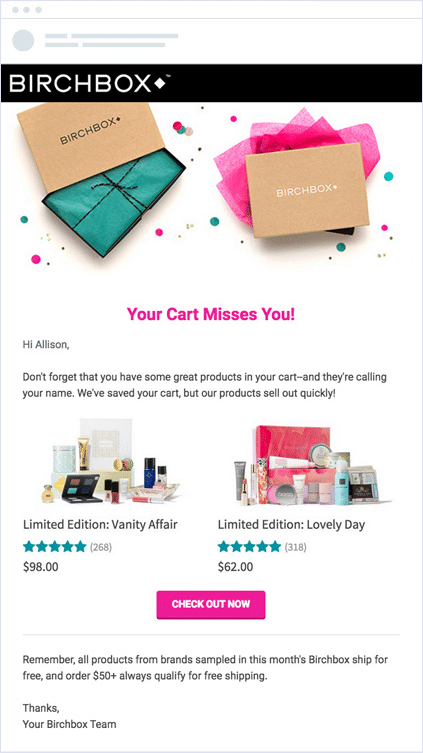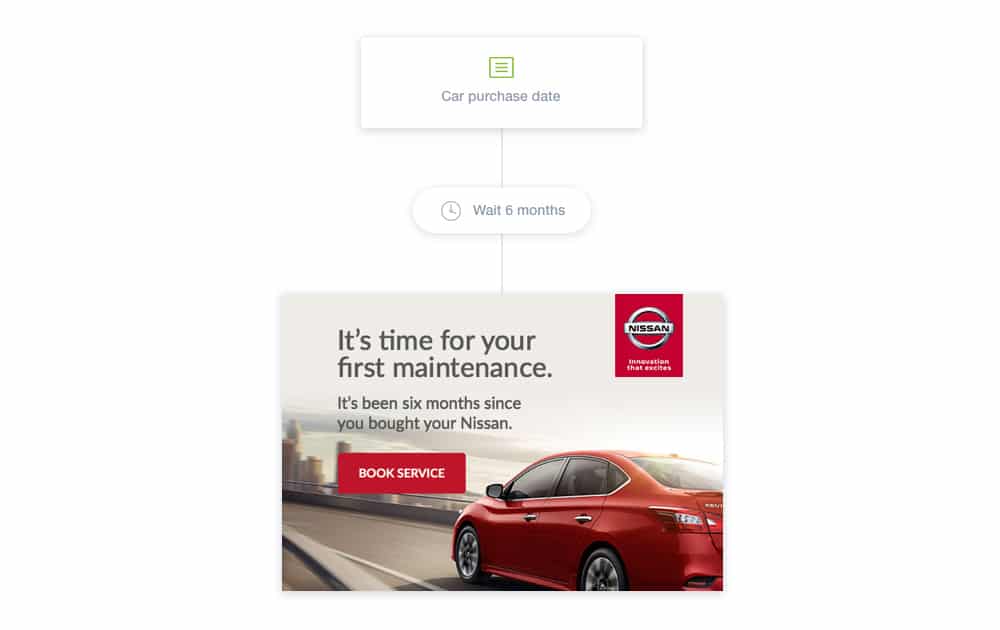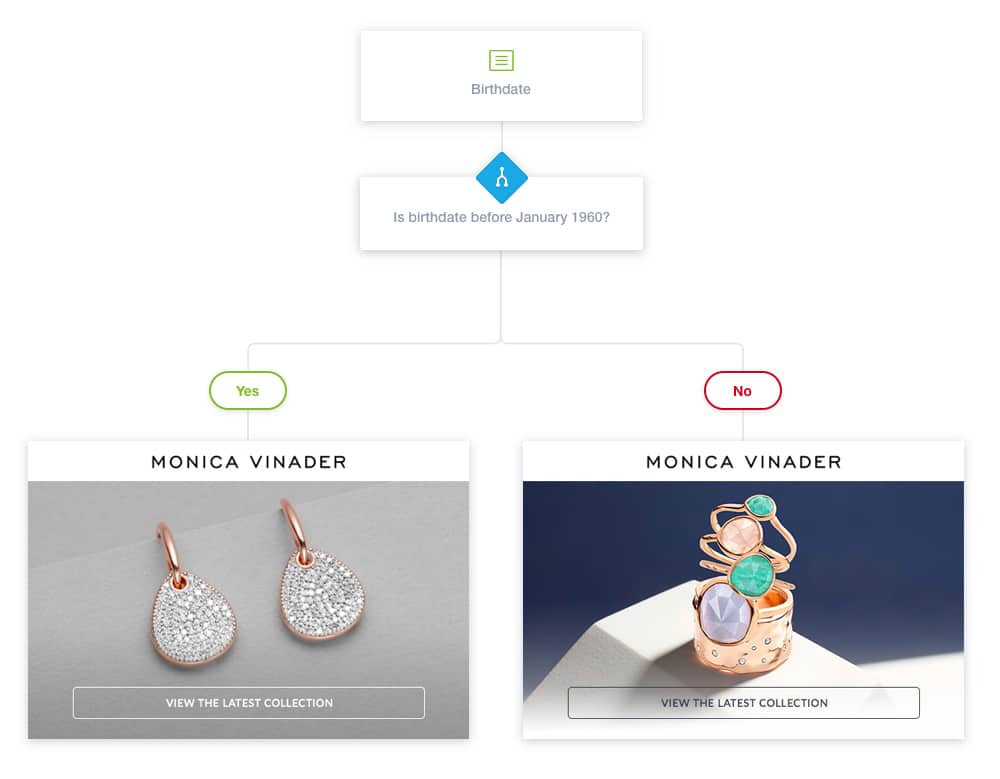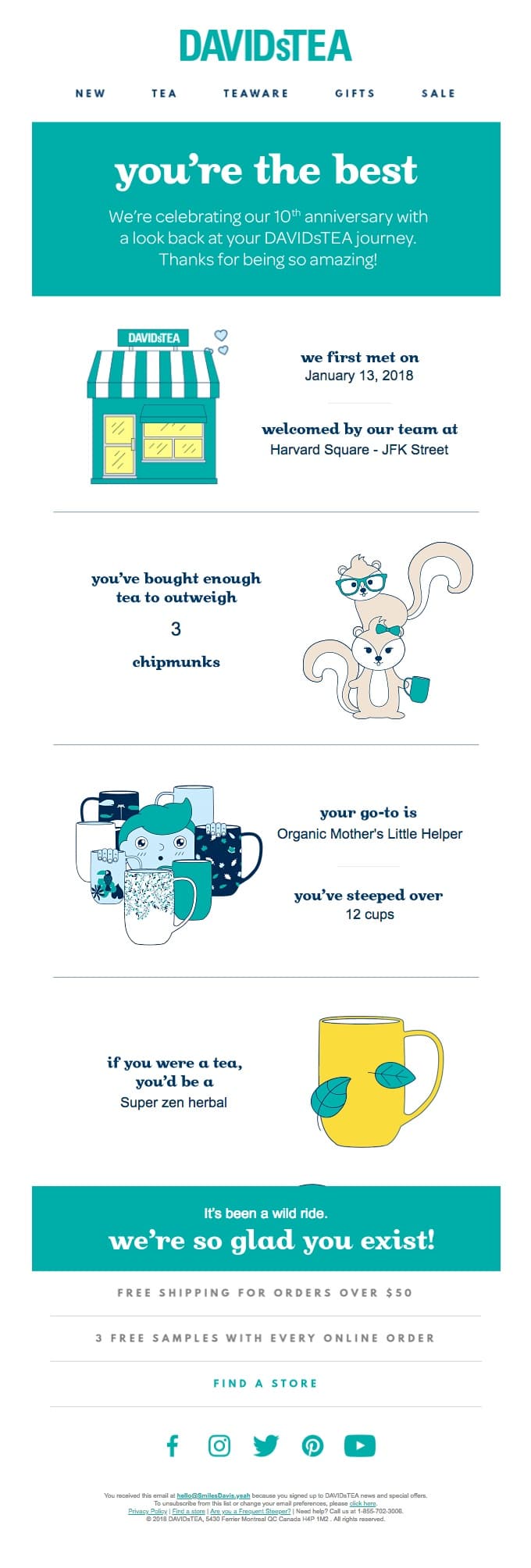Introduction
Consumers have come to demand and expect relevant and personalized content and experience, both online and offline.
To meet those demands, marketers are striving to leverage email personalization to move toward 1:1 experiences that not only meet, but exceed consumer expectations and set them apart from the competition. That’s why it’s not surprising that, when asked to prioritize one capability that will be most important to marketing in the future, 33% of marketers answered: “personalization.” Furthermore, 74% of marketers say targeted personalization increases customer engagement, and they see an average increase of 20% in sales when using personalized experiences.
Read on to learn some of the basic personalization tactics like personalizing an email subject line, as well as more sophisticated techniques like using dynamic content or behavioral data based on how consumers are engaging with your brand. Marketers at every level and ability can reap the benefits of sending more relevant and personalized messages that get results.
Chapter 1
What is email personalization?
Personalization, in the context of email marketing, is the act of targeting an email campaign to a specific subscriber by leveraging the data and information you have about them. It could be information like their first name, the last product they bought, where they live, how many times they log into your app, or a number of other data points.
Personalization is a broad term, and it can vary in sophistication. Basic email personalization includes tactics like using a subscriber’s name in the subject line, while more advanced tactics can include changing the content of the email based on a subscriber’s gender, location, or other things you know about them.
Personalizing your email campaigns is a proven way to increase your open and click-through rates and can have a measurable impact on your ROI and revenue. Studies have shown emails with personalized subject lines are 26% more likely to be opened than those without, and Rich Relevance found that revenue is 5.7 times higher in emails that employ personalization.
These results stem from the fact that personalized emails are more relevant to subscribers. Instead of receiving a campaign with generic offers and messaging, your subscribers will receive an email that is targeted directly at them, includes their name, and provides offers (products, promotions, etc.) that are relevant to their interests.
Chapter 2
What is a personalized email?
One of the most commonly used personalization strategies is using the recipient’s first name. However, personalization in an email goes further than simply using your subscriber’s first name.
So what exactly is a personalized email?
The following are 3 main elements that make up a personalized email:
1. Relevant
The main cornerstone of a personalized email is relevance. People’s inboxes are cluttered, with the average worker receiving at least 121 emails per day, and, often, those emails will address the recipient by name.
To take email personalization further and grab your subscriber’s attention, offer relevant content. If your content doesn’t directly impact your reader, your email has high chances of being relegated to the trash box.
2. Timely
Another hallmark of a personalized email is that it has to be timely.
By gathering enough data about your subscriber, you can know what kind of content they need at a particular stage of their customer journey with you.
For example, if they search for a particular topic or solution on your website, you gain insight on what they need at that point in time and can then craft and send them a timely email.
3. Comes from a person
People are more likely to trust and relate to an email that comes from another person, as opposed to a business. You need to use a person’s name in the “from” field and use a face instead of a logo.
Chapter 3
What can be personalized?
Using professional-grade email marketing tools like Campaign Monitor, almost every part of your email marketing campaigns can be personalized, using tactics that range from the simple to the more advanced. We’ll cover each of these tactics so you can understand the realm of possibilities.
It’s entirely possible to start simple and then work your way toward more advanced tactics as you go along. The key is to use personalization in big and small ways to add value to your customers’ experiences.
Basic Email Personalization Tactics
Most marketers using basic personalization tactics are looking to do email newsletter-type marketing. They may not have the resources or bandwidth to focus on email personalization, but some basic tactics can help them get better results from their efforts and increase their engagement metrics.
1. “From” name
The “from” name is one of the most prominently displayed elements of your campaign when it arrives in your subscriber’s inbox.
On many desktop and mobile clients, this field has a larger text and heavier font to help people quickly identify who the email is from before the recipient opens it.
Given its prominence, it’s unsurprising that 68% of Americans say they base their decision to open an email on the “from” name.
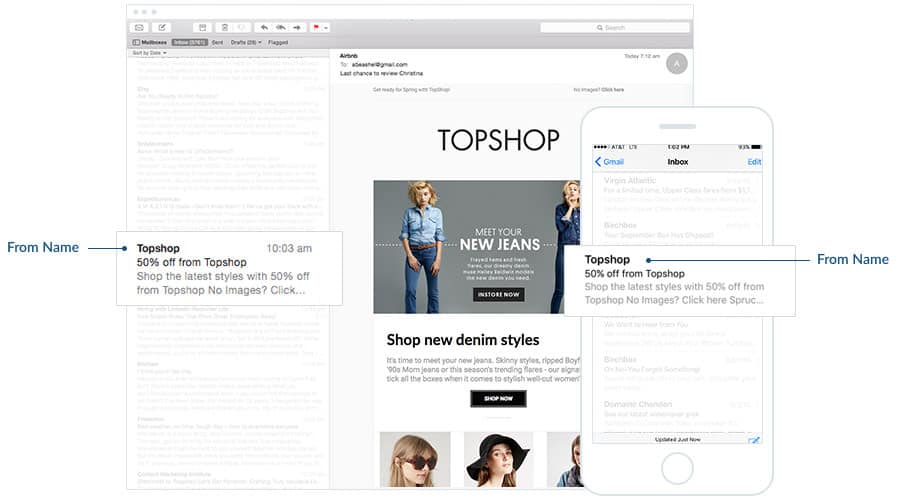
To appeal to these people and get more of them to open your campaigns, you can personalize the “from” name of your emails so that different subscribers see different names.
A common use case for this is sending your marketing campaigns from the individual sales representative or account manager that is currently working with a particular account.
Dubsat does a good job of this in their promotional campaigns, dynamically changing the “from” name so that the email campaign appears to come from the account manager the client interacts with regularly.
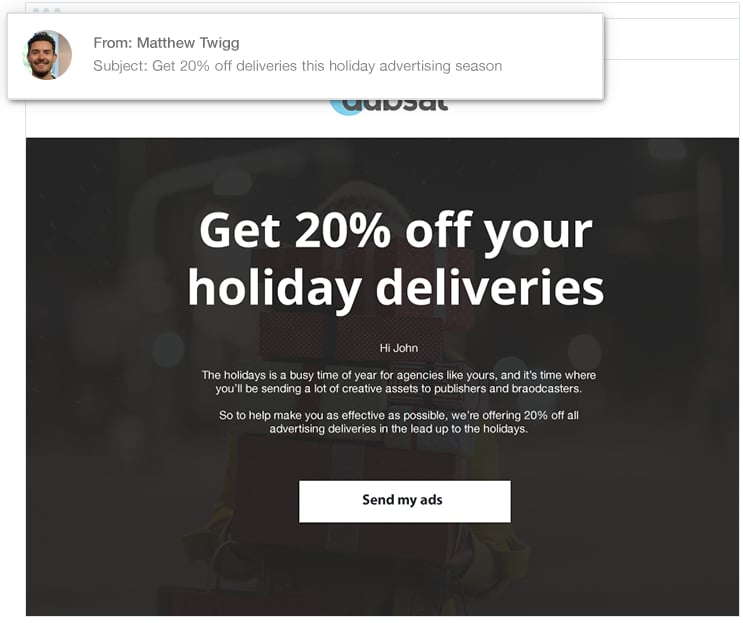
If you’re a Campaign Monitor customer, you can do this easily using Personalization Tags.
As you create your campaign, you simply enter the Personalization Tag you wish to use in the “from” name area. Then, when you send your campaign, it will automatically be replaced by the information you have stored in your email list (i.e., the name of the sales representative who is working with the account).
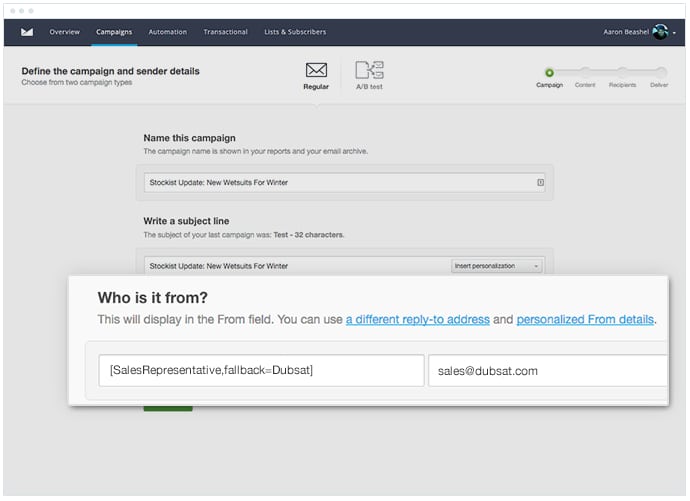
2. Subject line
After the “from” name, the subject line is the second most prominent element in the inbox.
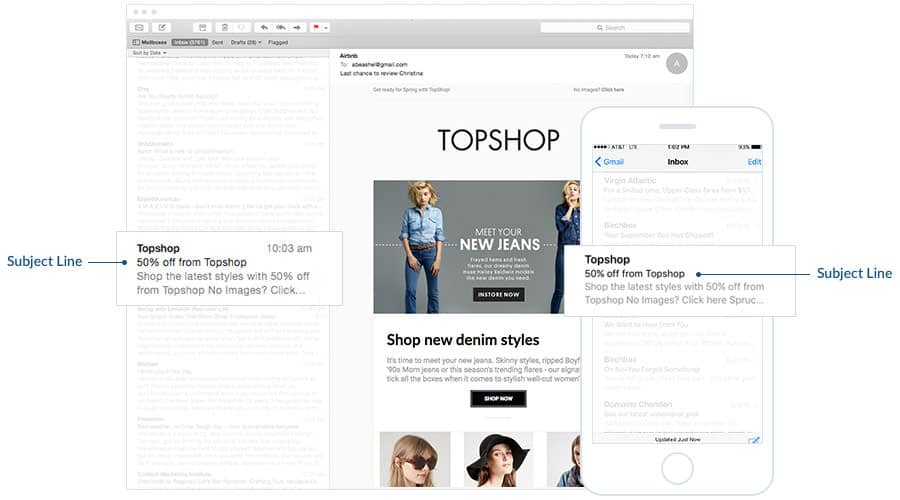
On most devices, the subject line has a darker, heavier text in an attempt to make it stand out among the other details of the email.
Given its prominence in the inbox, it’s inevitable that your chosen subject line will have a significant effect on open rates, and our research shows that using the recipient’s first name in the subject line can increase open rates by 26%.
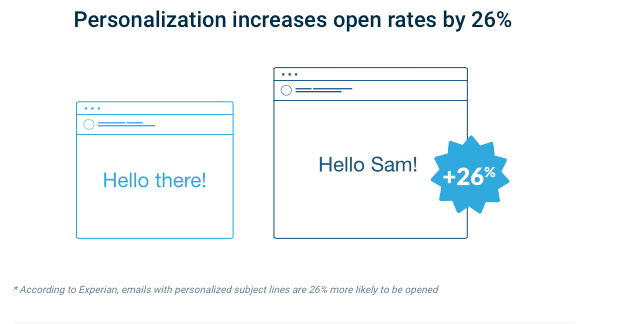
Converse does this well in their email campaigns, adding the subscriber’s first name to the subject line to help the campaign stand out in the inbox and get people to open.
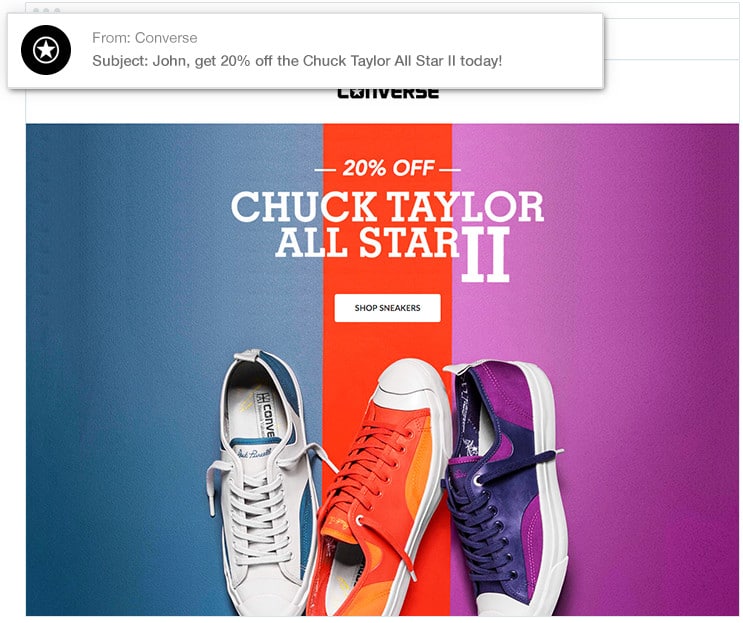
If you’re a Campaign Monitor customer, you can do this using Personalization Tags.
When writing your subject line, simply click the “Insert Personalization” button and you’ll see a list of the different Personalization Tags you can insert into your subject line. Then, when you send your campaign, it will automatically be replaced by the information you have stored in your email list (i.e., the first name of the subscriber.)
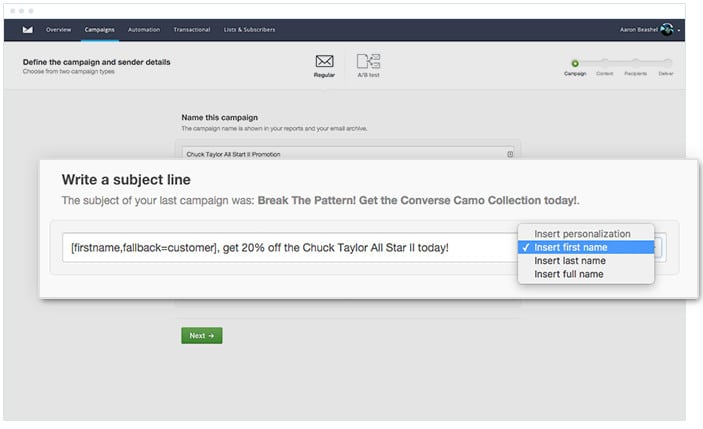
Medium sophistication email personalization tactics
Marketers that are utilizing medium sophistication personalization tactics are starting to develop deeper relationships with consumers, and are moving toward marketing that is more targeted and fosters even higher levels of engagement.
1. Email content
Beyond just the “from” name and subject line, there are also many ways in which you can personalize the body content of your email campaigns to make them more relevant to subscribers and increase the chance they’ll click through.
2. Copy
If you have your subscriber’s first name, company, or even t-shirt size stored in your email list, then you can easily use that information to personalize the text in your email campaigns.
The most common example of this is adding a subscriber’s first name to the email, like this example from Sephora, who included the subscriber’s first name to address them more directly.
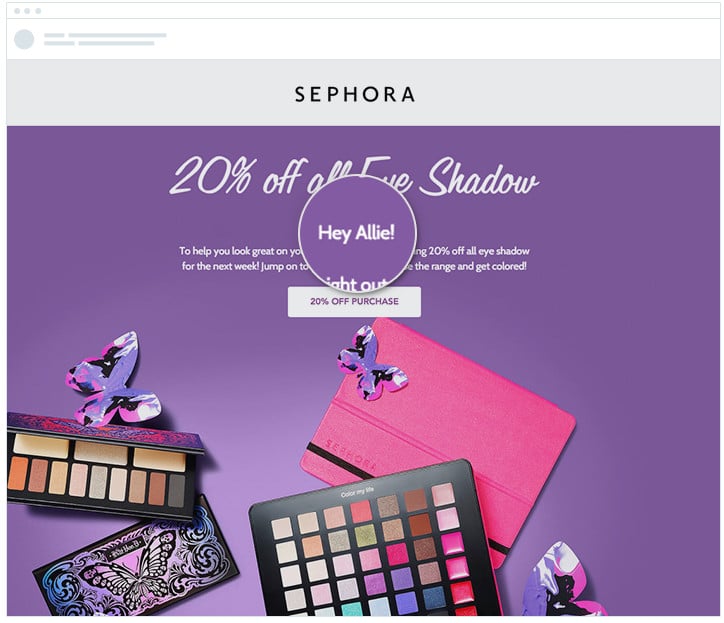
While first name personalization may be the most common example, it is far from the only thing you can do.
Using custom fields, you can store any piece of information you choose on your subscribers (e.g., gender, t-shirt size, birthday, etc.) and then use it to personalize campaigns.
Dropbox does an excellent job of this, including the subscriber’s company name to take the personalization to a new level and increase the relevance of the email for the reader.
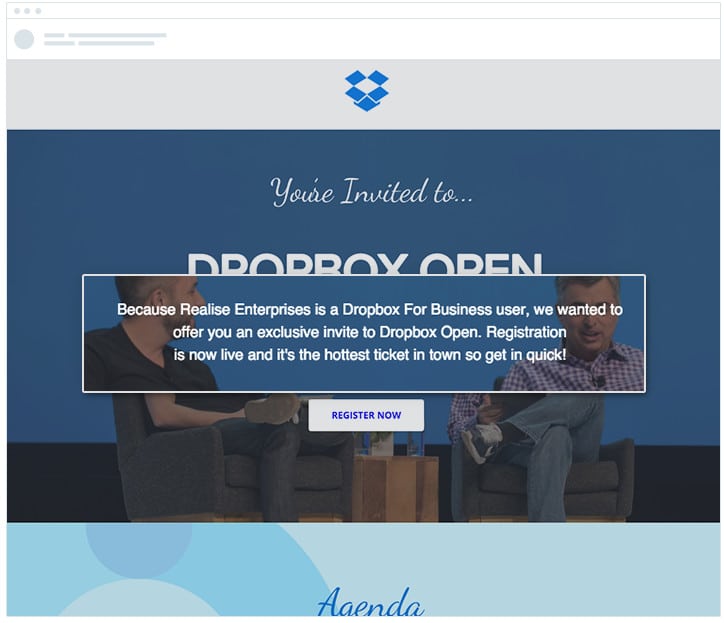
If you’re a Campaign Monitor customer, you can personalize your copy directly in the drag-and-drop email builder.
Simply select the “Insert personalization” drop-down, and you’ll see all the different Personalization Tags available. When you send your campaign, the tags will be automatically replaced by the information you have stored in your email list (i.e., the first name of the subscriber.)
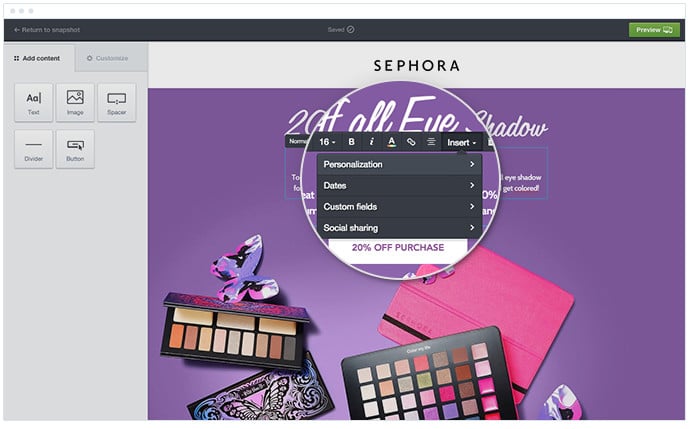
3. Imagery
Beyond just text, you can also dynamically change the images in your email marketing campaigns to better appeal to specific subscribers.
Using imagery is a powerful way of increasing your email click-through rate. In fact, in a recent campaign, we tested dynamically changing the images to match the subscriber’s location. We created different images for people in the UK, USA, and Australia and tested them against a generic version (with just one location-agnostic image) to see if personalized images worked better.
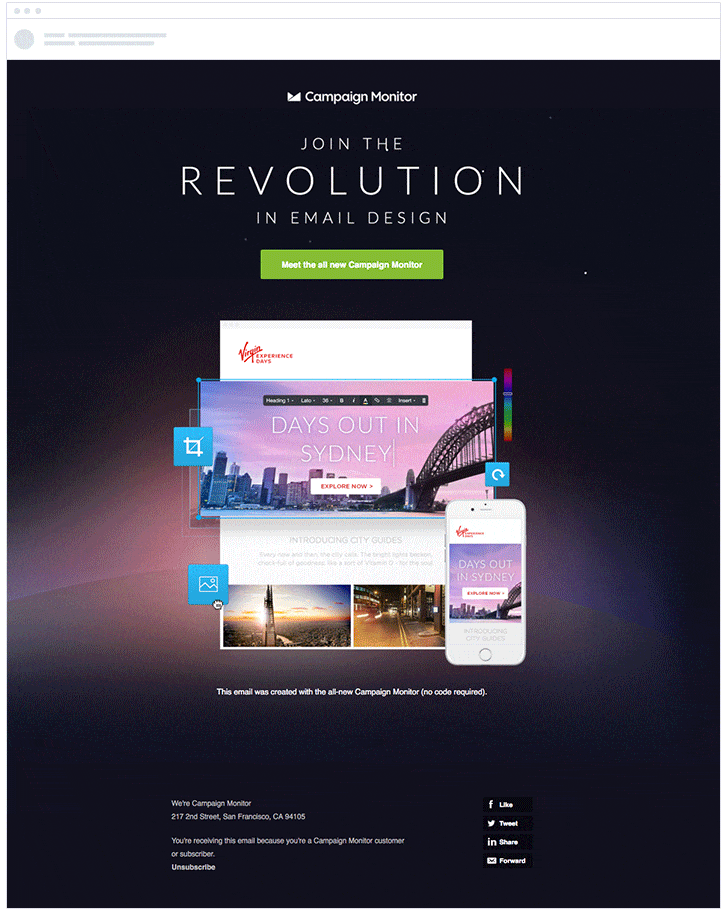
By making the images in our email campaign personalized to the subscriber’s location, we were able to increase our email click-through rate by 29%.
If you’re a Campaign Monitor customer, you can easily do this in the email builder. Simply select the images you wish to personalize, and then select the segment of your list you want it to show for (i.e., subscribers in Australia).
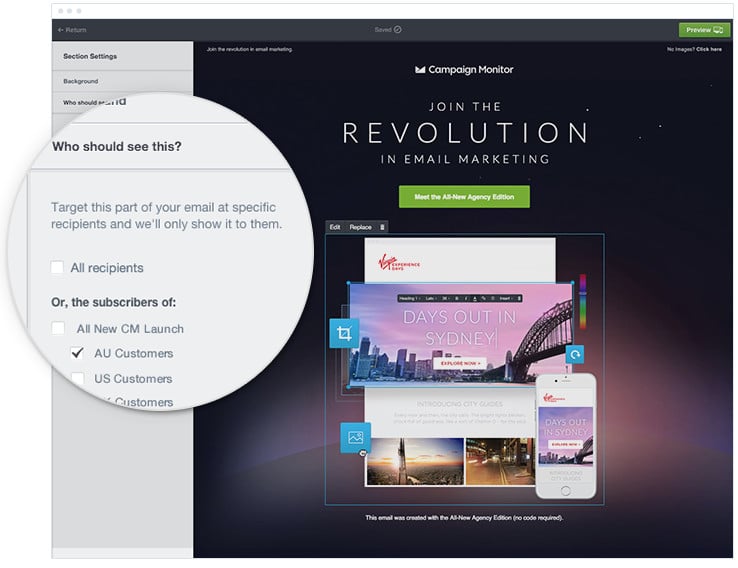
4. Dynamic content offers
Savvy brands are using demographic and geographic data to personalize the offers delivered to each consumer. You can dynamically change entire sections of content within your email to make the entire campaign more relevant and more appealing to subscribers.
A common use case for this would be showing menswear to your male subscribers, while showing womenswear to female subscribers.
Adidas did this in their email campaigns for the Originals series. By dynamically switching the products being promoted based on the subscriber’s gender, they ensured each subscriber saw the most relevant and appealing products that would entice them to make a purchase.
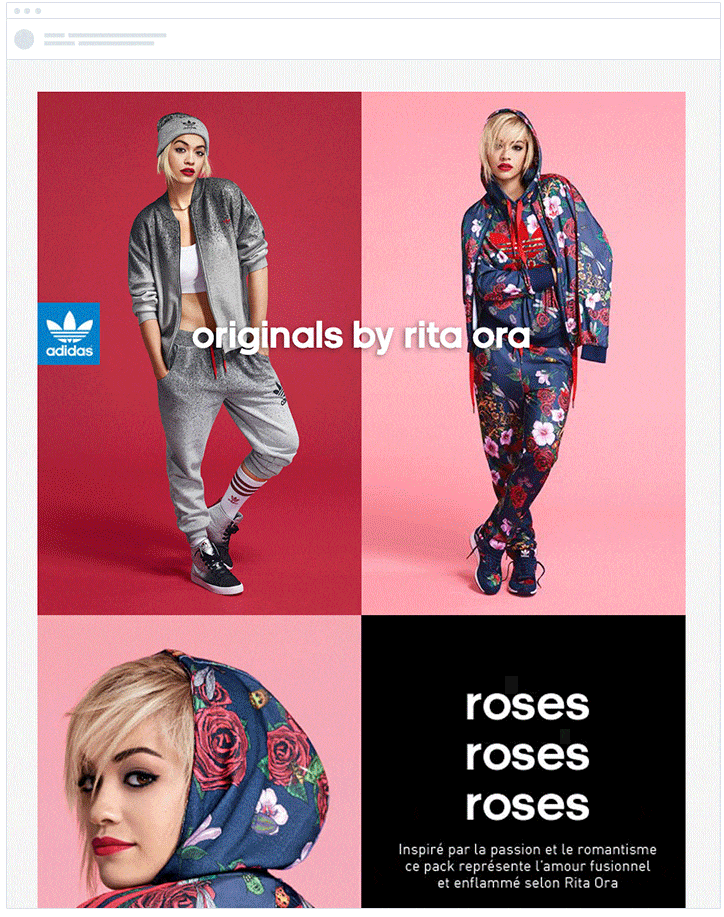
If you’re a Campaign Monitor customer, you can easily do this in the email builder. Simply select the section of content you wish to personalize, and then select the segment of your list you want it to show to (i.e., male subscribers).
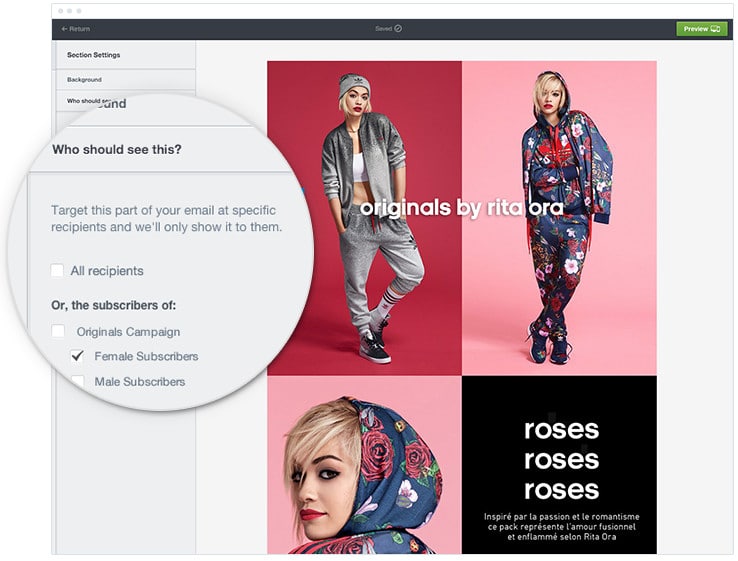
5. Re-engagement
You can use email marketing personalization and automation to encourage customers who have already engaged to come back.
For example, St. Jude Children’s Hospital automatically sends reminders to re-engage their past donors. They’ll automatically receive a message six months after donating to remind them of St. Jude Children’s Hospital’s impact that encourages them to donate again.
To re-engage inactive subscribers, you can send a re-engagement campaign asking them if they still want to hear from you. You can also send special promos, thank you notes, or actively ask them for their feedback. Remember, this should be a pull-out-all-the-stops, best content, best offer kind of email because this may be the last chance you have to impress your subscribers.
St. Jude powers these emails with data that they collect at the time a donation is made. That data is then fed into their email marketing and automation provider, making it effortless to power the related customer journeys that follow. By proactively sending a reminder email, St. Jude increases the likelihood that a donor will make a repeat contribution and stays top of mind with their audience.
Advanced Sophistication Email Personalization Tactics
Marketers with specific use cases who may be utilizing customer journeys and automation, as well as other, more advanced tactics, can employ personalization techniques using data from other sources to create a highly personalized experience. They may be capturing data about consumers via their email service provider, CRM, e-commerce platform, website behavior, and other third-party applications.
Marketers with this rich data can employ behavioral segmentation creating dynamic segments based on a consumer’s engagement with their brand via multiple channels.
This a game changer for more advanced marketers because it takes the constant, manual data management aspect out of email segmentation and personalization. It’s the foundation for a highly personalized strategy.
Read on to learn about some use cases and examples of more advanced personalization tactics you can use to deliver highly relevant messages and experiences to your subscribers and customers.
1. Product recommendations
By integrating a customer’s recent purchases or browsing history into their email marketing, marketers can leverage customer behavior to create relevant, engaging email campaigns that boost purchases through cross-selling and up-selling product recommendations that are merchandised to each unique recipient in your email list.
Retailers and e-commerce sites can now easily create real-time, one-to-one targeted content that speaks right to the individual to create a long-term relationship and increase the lifetime value of that customer.
Consider the following example. This portion of an order confirmation email from Nordstrom contains a section at the bottom that displays product recommendations based on items the customer viewed but didn’t buy:
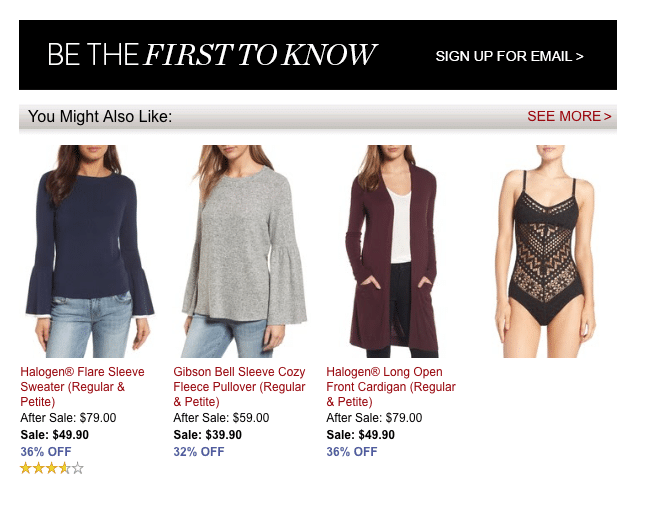
Brooklinen sends an email composed of images of the products the consumer recently browsed but did not purchase, reminding them that the sheets they looked at are still available with an easy call-to-action button. They even include a free shipping offer.
2. VIP loyalty
Sephora, a cosmetics company, uses marketing automation to automatically send a series of special offers to their best customers once they’ve reached VIP status, which is triggered by a spending threshold.
Using automation, they take their customers on a personalized journey, tailored to each subscriber’s behavior. For instance, if a customer reaches VIP status, they receive a different email than a customer who doesn’t reach the spend threshold.
Sephora then continues that journey based on how the customer engages with each message. This kind of segmentation allows marketers to deliver the most relevant message to each subscriber, driving stronger engagement and revenue.
You can use integrations with systems like Shopify to leverage the powerful customer data to create targeted, timely email marketing campaigns.
3. Purchase abandonment
Every online retailer and e-commerce company knows that, just because someone puts an item in their shopping cart, doesn’t mean they’ll purchase it. The digital shopping cart abandonment rate is 74.3% worldwide. That roughly translates to only 1 in 4 carts getting “checked out.”
Whether the consumer had second thoughts, got distracted, or simply ran out of time, it’s nice to know that you can still try to get the customer to come back using email marketing and automation.
For example, by tracking their customers’ website behavior and tying that data into their email marketing platform, Birchbox can know when someone begins the checkout process but doesn’t complete it and abandons their purchase. When this happens, Birchbox automatically sends an email reminding them that they still have items in their cart. It encourages the customer to go back to the site to complete their purchase and includes images of the products left behind.
4. Behavioral segmentation
Travel company Flight Centre compiles data from their email, social properties, and back-end systems. With that data, Flight Centre creates highly targeted segments based on customer interests, behavior, and engagement with their marketing properties. Then, using those segments, Flight Centre triggers automated customer journeys with personalized vacation offers to promote higher bookings.
For example, here’s an email that showcases dynamic imagery for a particular persona (someone interested in cruises) with a personalized offering. This email features:
- Personalized imagery and lead-in content
- A sense of urgency through the use of a deadline
- Personalization: first name, consultant worked with in the past
After implementing behavioral segmentation, Flight Centre saw a huge impact to their metrics.

Chapter 4
How to get the necessary data
If you want to personalize your email campaigns, then you first need to have information like names and locations stored in your email list. The data you have about your subscribers allows you to segment your audience, which is the key to creating more targeted emails.
If you’re a Campaign Monitor customer, any lists you create will automatically be set up with fields to store subscriber’s first name, last name, and email address. However, if you want to capture more in-depth data on your subscribers (like their location, gender, or birthdate), you can also set up custom fields to record these attributes.
Once you have your custom fields set up, it’s then a matter of capturing the right information and sending it into your Campaign Monitor account. There are a few ways to do this:
1. Using your email subscribe forms
By adding some extra fields to your email subscribe forms, you can capture extra details about your subscribers that allow you to personalize your campaigns.
Topshop does a great job of this with their subscribe forms, capturing the subscriber’s date of birth, location, and work status, along with standard details like name and email address.
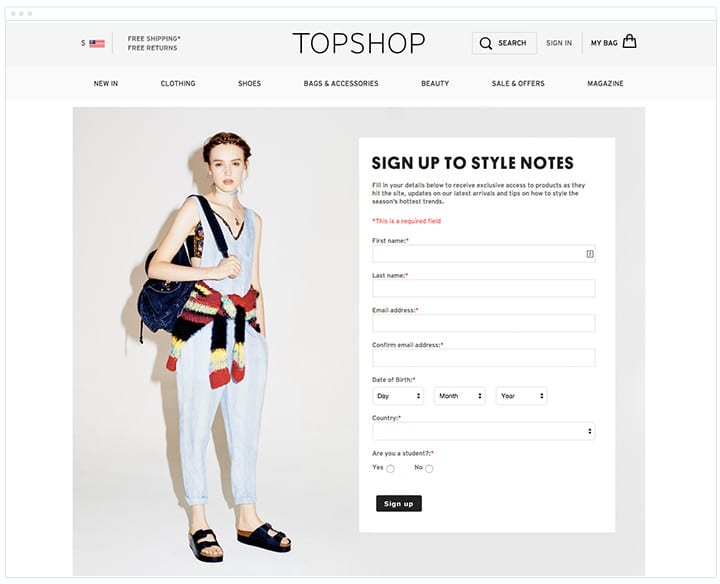
2. Using integrations
If you primarily send email campaigns to your existing customer base, then integrating your email marketing tool with your CRM, e-commerce platform, or accounting package can be a great way to obtain extra details about your subscribers that allow you to personalize your campaigns to them.
Email marketing tools like Campaign Monitor have deep integrations with popular tools like Salesforce and Shopify, which will import the name and email of your subscribers, as well as other information, such as their location, status, the total number of orders, the total spent, and more.
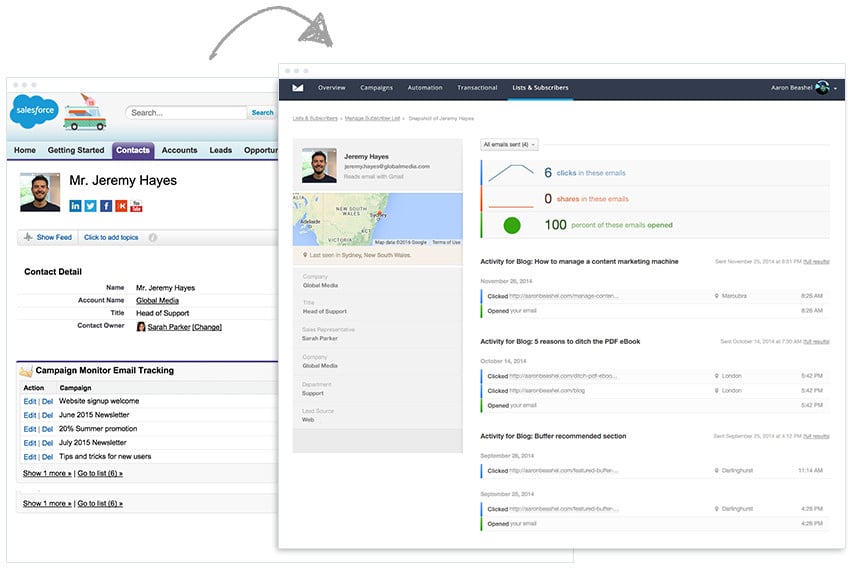
With detailed information on your subscribers coming in through your subscribe forms and integrations, you’ll have everything you need to start personalizing your email campaigns and driving increased open and click-through rates.
3. Using third-party apps
A lot of customer data is often stored in third-party apps that may not have a pre-built integration. Leveraging an API opens up a world of possibilities for integrating your email platform with your third-party software to create effective segmentation based on customer data. With tools like Campaign Monitor’s robust API, you can connect all your core business apps to meet your unique email marketing and automation needs.
4. Website behavior tracking
By tracking browser activity on your website or e-commerce platform, you can collect massive amounts of behavioral data about the interests and preferences of your customers. This data can be invaluable in crafting emails with product recommendations, cart abandonment reminders, limited time discounts, and dynamic content that resonates on a personal level. While several third-party apps track web behavior, ESPs like Campaign Monitor can also integrate with Google Analytics to provide data on the website visits and clicks of your email audience, and leverage that data in both the building and sending of emails. It’s an integral way to move towards a one-to-one email marketing strategy.
Chapter 4
Marketing Automation & Personalization
Marketing automation uses “customer journeys” that begin with a trigger, like signing up for a newsletter, making a purchase, or sharing an email. These journeys are designed to be more relevant to the recipient, and they’re easier for marketers to execute since journeys as they are set up once. This style of email marketing is also valuable because it creates an ongoing conversation with your subscribers and customers, and builds brand loyalty. Marketing automation generates ROI, revenue, and results.
B2C and B2B companies all use marketing automation to send more personalized, timely, and relevant messages that result in higher engagement and revenue. No matter what tool or platform is used, marketing automation can be distilled to three core components: triggers, rules, and content.

As marketers use automation to deliver personalized messages at scale, they need to consider the messages they want to send, who they want to send them to and when, and the data that is needed to power these sends. The data can be used as a trigger for a particular message or journey to begin sending to a segment of subscribers.
Nissan auto dealerships automatically send new car buyers service reminders six months after their purchase, which results in new sales opportunities (all without any manual data entry or manipulation). Nissan is a perfect example of using the data they have about their customers to send relevant messages that deliver revenue again and again.
Another excellent example of using marketing automation comes from jewelry retailer Monica Vinader. They know that birthdays are a great way to generate revenue, so they collect this data during their checkout process and sync it right to their list. Then, when their subscribers’ birthdays roll around, the retailer uses marketing automation to send an offer for 10% off automatically.
By recording the customer’s birthdate, Monica Vinader can send out an automated birthday email that reminds customers to engage with the brand, which can lead to more ROI and revenue for the brand.
2 examples of highly-effective personalized emails to inspire you
Examine the following examples of highly personalized emails to help give you more of an idea of what this can look like.
1. DAVIDsTEA
Source: Really Good Emails
This email from DavidsTea is a classic example of using data to send a personalized email. By showing that they know the recipient’s preferences and the day he became a customer, they are showing that they value the customer’s relationship and not just the business they bring.
People love being noticed and appreciated, and that’s what this email does for the subscriber. It shows they are not just one of many customers but an appreciated individual.
2. Meetup
Here’s another wonderful example of a personalized email from Meetup:
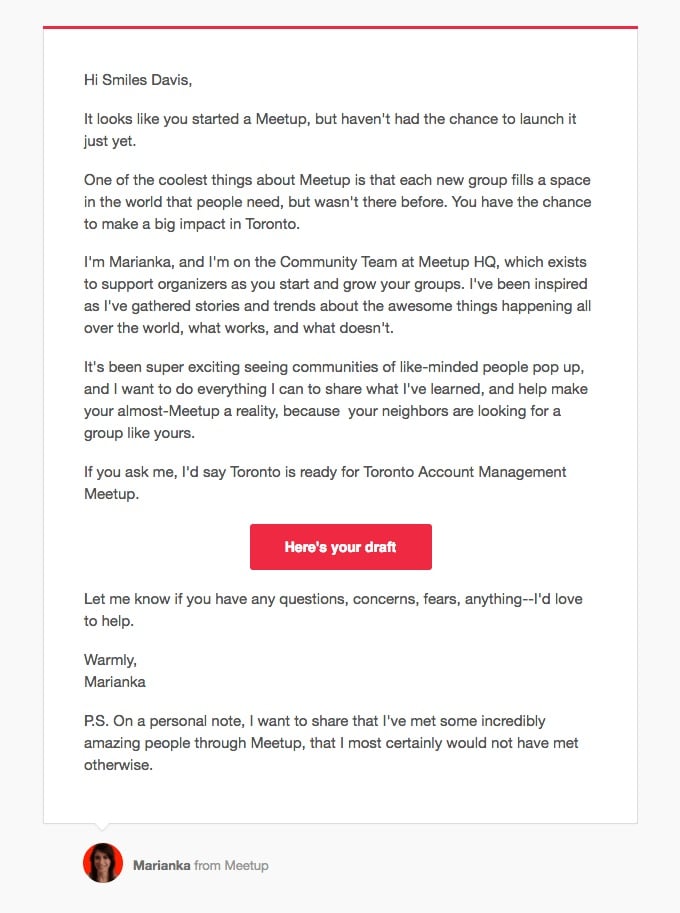 Source: Really Good Emails
Source: Really Good Emails
This email takes personalized email marketing a step further by:
- Reminding the subscriber of the abandoned action on their platform, which helps the subscriber know immediately who the email is from and why it’s relevant.
- They are using personal words. Being a platform that focuses on relationships and enhancing them, Meetup chooses the wording of their email carefully by using words like “make a big impact,” “inspired,” and others.
Chapter 5
Wrapping up - Your checklist for personalizing email
Personalizing your email campaigns is a proven way to deliver incredibly targeted and relevant content to your customers and prospects, adding value to their experience along the way. In return, you can drive increased ROI and revenue for your growing business.
Here’s what you need to keep in mind:
- To craft the most effective personalized email, gather as much data about your subscriber as possible
- Personalized emails drive the highest engagement and revenue
- Carefully segment your list to enhance your personalization
By collecting the right data at the right time and using powerful, yet easy-to-use tools like Campaign Monitor, personalization has never been easier and more accessible. Here are a few more email personalization tactics to help you create a winning campaign.

Press CMD+D to Bookmark this page

Send personalized messages to the right audience
From personalized subject lines to dynamic content to send time optimization, Campaign Monitor helps you build campaigns catered to every last subscriber.
Learn more
Case Study
Discover how this media brand grew their email list from 30k to 100k in less than a year.
Learn how
The email platform for agencies
We started out helping agencies with email, so let us help you.
